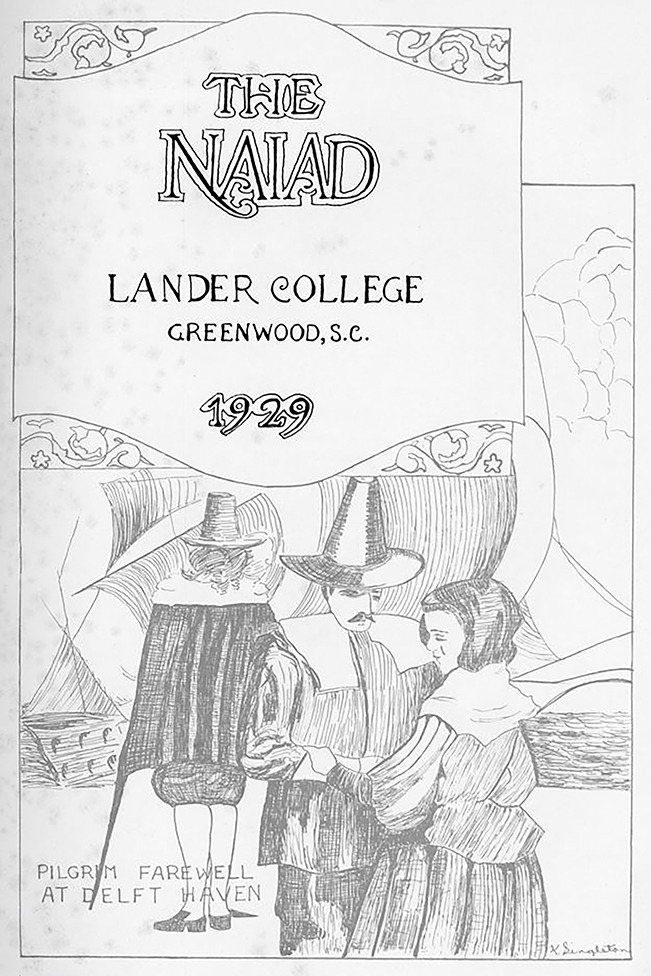Editor’s Note: During the Sesquicentennial Celebration of Lander University, this series will take us into the University’s archives for photos and brief stories about the college and its growth.

From services in the chapel to a sumptuous holiday meal, the Rev. Samuel Lander and his wife, Laura McPherson Lander, established festive traditions to ensure that Thanksgiving was memorable for students, faculty, and staff at Williamston Female College.
A posting in the Naiad newsletter in 1884 made note that Thanksgiving Day “was duly and joyously observed in our village, and especially in our College household. From dawn to curfew, including the holiday, the service in the church, the stately dinner – with the inevitable Boston baked beans, the traditional pumpkin pie, the turkey with cranberry sauce, and the countless other luxuries from far and near – the free and easy interchange of homely courtesies, and the closing reunion in the Erosphic Hall, everything went merry as a marriage bell.”
That baked beans were a menu item in the early years of the College may not be as strange as one would think. According to the Bean Institute, eastern Native American tribes “buried pots of beans flavored with maple syrup in the ground in an oven made of heated rocks and let them bake for days. It’s likely that they taught the European settlers how to make them. As authentic early American cuisine, baked beans have a place on any holiday table, whether or not they were served at the three-day event that eventually gave rise to our Thanksgiving.”

The 1902 Thanksgiving menu at the College featured some foods unfamiliar to modern holiday tables, including “possumed potatoes” and “Saratoga chips,” as well as Carolina rice, chicken salad and the traditional turkey, cranberry sauce, and fresh ham.
When the College moved to Greenwood and became Lander College in 1904, the forerunner of Lander University, the holiday meal continued as an important campus tradition. An article on Nov. 23, 1905, in The Index-Journal reported that the “Ladies Society of the Presbyterian church will supply the bread and cake, and other dainties for the Thanksgiving dinner at Lander College.”
In a follow-up article in the Dec. 7 edition of the newspaper: “Thanksgiving Day is always a red letter day in this college. We had a time beginning by hearing a capital sermon, preached by the Rev. Dr. H.A. Bagby. Our dinner was called at 3:30 p.m. and it took two hours to do justice to the dainties and to the feast following.”
Thanksgiving was quite celebratory, too. An article about Lander’s Thanksgiving in 1910 stated that the day began with students attending “the service to which all the community united at the Methodist Church. Three hours later, the dinner was a most interesting feature. The dining room was decorated with large flags, ferns and cut flowers, and a tiny flag was placed at each plate along with a menu card. The dinner was delicious and the speeches that came afterward were greatly enjoyed.”
Those speeches included toasts given by students and faculty. Of Lander College, a student said, “One of the best, one of the most modest.” In a nod to the class of 1911, Bessie Herbert said, “What will they be in 1921?” Elsie Smith said of the faculty, “In Heaven above, where all is love, there’ll be no faculty there.”
For many decades, Lander students did not go home for Thanksgiving. Travel was expensive and time consuming. On Nov. 24, 1914, The Index-Journal reported, “Lander College will close only one day, Thursday, for the Thanksgiving holidays. None of the students will be permitted to go home.”
The travel of the Pilgrims, who came to America in 1620, was likened to the journey taken by students on their academic path when editors and writers produced the Naiad yearbook in 1929. The publication’s cover featured an embossed ship with full sails. Inside, the pages were adorned with charming black-and-white illustrations of Pilgrims and Native Americans.
From the foreword of the yearbook: “When you have pilgrimed far and success has crowned every effort made along the way, may this volume of the NAIAD remind you who have scarcely begun the Pilgrimage of the way in which you began it. May it remind you who are in the midst of it, of the worthy aim towards which you are directed. May it remind you who are ending the Pilgrimage and leaving your Alma Mater of the victory which comes as the result of conscious effort.”